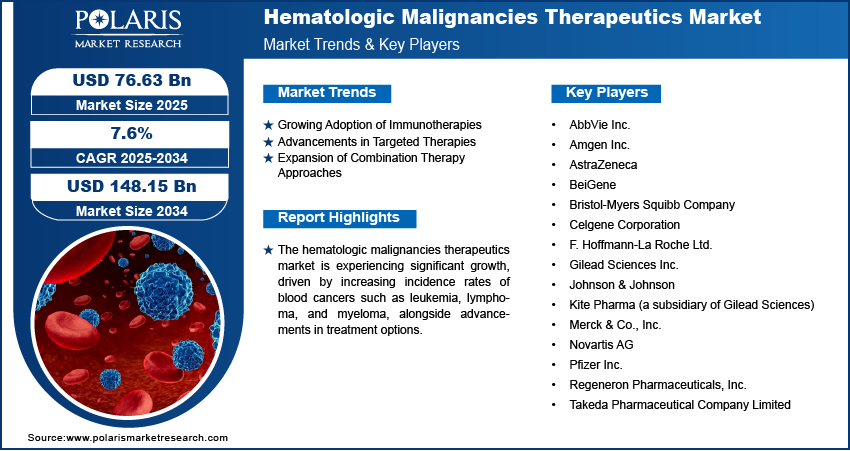
Hematologic Malignancies Therapeutics Market [By Type (Leukemia (Acute Lymphocytic Leukemia, Chronic Lymphocytic Leukemia, Acute Myeloid Leukemia, Chronic Myeloid Leukemia), Lymphoma, Multiple Myeloma, Others); By Therapy (Chemotherapy, Radiotherapy, Immunotherapy, Stem Cell Transplantation, Others); and By Regions (North America - U.S., Canada; Europe - Germany, UK, France, Italy; Asia-Pacific - China, India, Japan, Australia; Latin America - Brazil, Mexico; Middle East & Africa)]: Market size & Forecast, 2018 – 2025
- Published Date:Jul-2018
- Pages: 100
- Format: PDF
- Report ID: PM1347
- Base Year: 2017
- Historical Data: 2015-2016
Report Outlook
The global hematologic malignancies therapeutics market size was estimated at USD 40.4 Billion in 2017 and is anticipated to gain significant traction over the forecast period.
Hematologic malignancies are forms of cancer that initiate in the cells of the blood-forming tissue, such as in the cells of the immune system or the bone marrow. Several types of hematologic malignancies include Leukemia, Non-Hodgkin lymphoma, Hodgkin lymphoma and Multiple myeloma. While exceptional in solid tumors, chromosomal translocations are a common origin of such diseases. This commonly leads to a different approach in diagnosis and treatment of hematological malignancies. Hematological malignancies constituted 9% of all newly diagnosed malignancies in the US in 2011, with data indicating lymphomas are more prevalent than leukemia or myeloma.
The global hematologic malignancies therapeutics market is majorly driven by the increasing incidences of lifestyle-related diseases. The inactive and unhealthy lifestyle of people resulting in a number of lifestyle-associated diseases requiring appropriate therapy is considered as a major factor in accelerating the growth of the global market. Moreover, growing global numbers of people suffering from leukemia and lymphoma are also augmenting the market growth. For instance, according to leukemia and lymphoma society reports, an estimated combined total of 174,250 people in the US are expected to be diagnosed with leukemia, lymphoma or myeloma in 2018.
Increasing focus on R&D activities and inventions in the healthcare sector is projected to boost the growth of the global market during the forecast period. Furthermore, the increasing awareness amongst consumers relating to the obtainability of proper as well as advanced treatments is anticipated to generate significant growth opportunities for the market players during the upcoming period.

Segment Analysis
The Global Hematologic Malignancies Therapeutics Market is segmented on the basis of type, therapy, and geography.
On the basis of type, the global market is segmented leukemia, lymphoma, multiple myeloma, and others. The leukemia is further segmented into acute lymphocytic leukemia, chronic lymphocytic leukemia, acute myeloid leukemia, and chronic myeloid leukemia. On the basis of type, leukemia was estimated to dominate the market. The major market share is due to the availability of products such as Imbruvica, Rituxan, and Glivec, which are estimated to be the highest revenue generating drugs. On the basis of therapy, the global Hematologic Malignancies Therapeutics Industry is segmented into Chemotherapy, Radiotherapy, Immunotherapy, Stem Cell Transplantation, and Others. Amongst all the therapies, chemotherapy is the most commonly used treatment with a particular drug or combination of drugs used.
Regional Analysis
In terms of geography, North America was estimated to dominate the global Hematologic Malignancies Therapeutics Market. The dominance is majorly attributed to the high presence of key market players, availability of branded drugs, established healthcare organization, and increasing government support in the region. However, Asia Pacific is expected to dominate the global market during the forecast period. Increasing awareness about early diagnosis, availability of effective treatment in emerging countries, such as India and China, growing healthcare expenditure, and high unmet clinical needs of patients, are some of the factors anticipated to significantly boost the market in the Asia Pacific.
Competitive Landscape
Major companies are focusing on small firms with a working methodology of securing the end goal to manage position in the market and are associated with mergers and acquisitions, key joint efforts, and novel item advancement to pick up profit share in the business. Some major key players in global market includes Pfizer, Inc., F. Hoffmann-LA Roche ltd, Sanofi-Aventis, Bristol-Myers Squibb Company, AbbVie, Inc., Novartis AG, GlaxoSmithKline PLC, Celgene Corporation, Johnson & Johnson Services, Inc., and Takeda Pharmaceutical Company limited among others.

